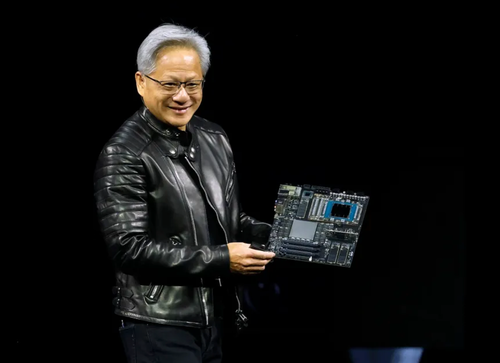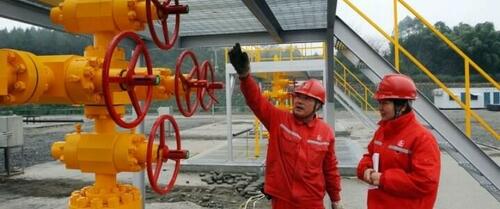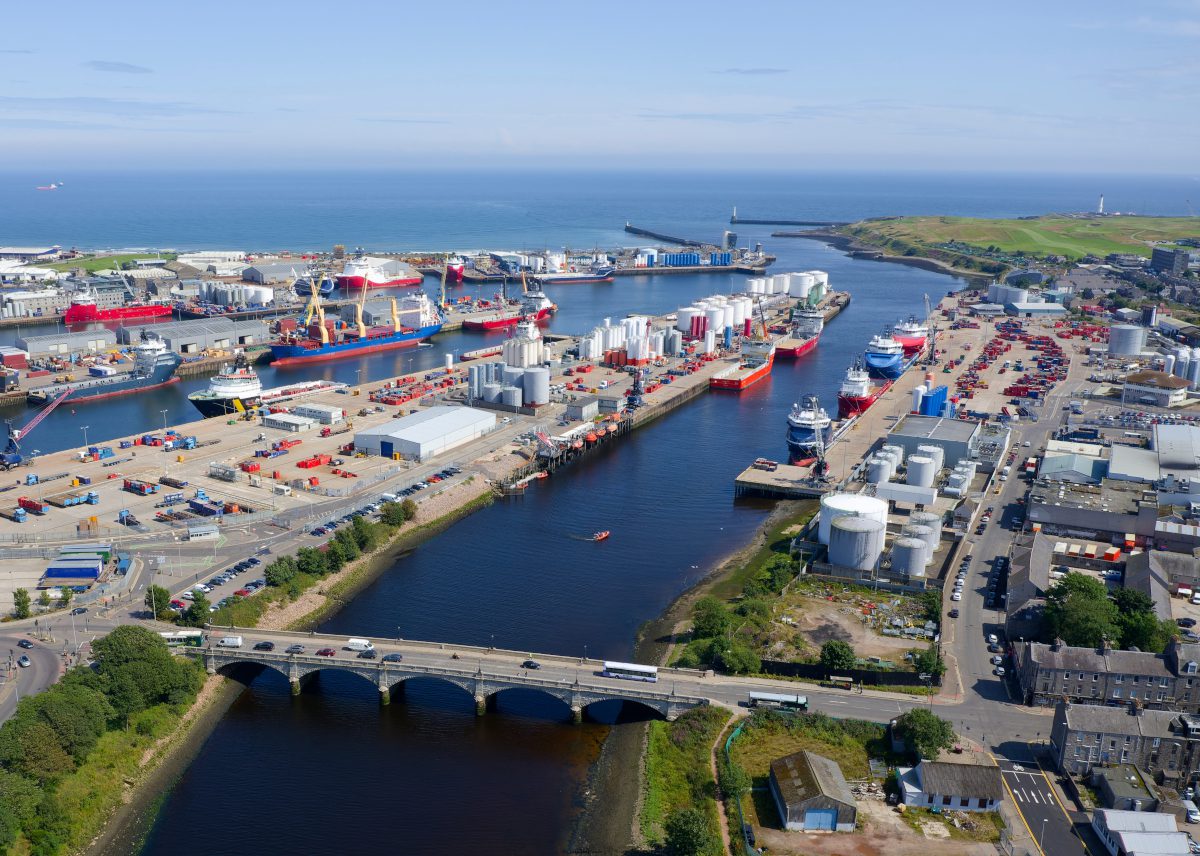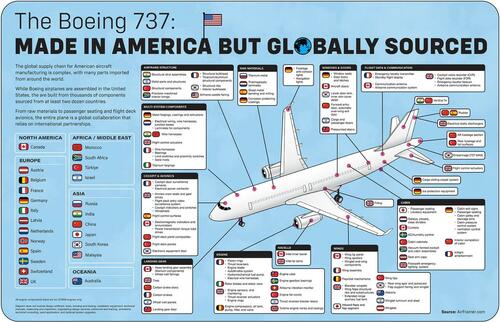Boeing 737: American Made But Globally Sourced
The Boeing 737 is often seen as a symbol of American aerospace excellence. But peel back the fuselage and you’ll discover a much more intricate story—one of international collaboration, supply chain complexity, and global interdependence.
The aircraft’s thousands of components are sourced from at least two dozen countries and multiple continents. While Boeing leads final assembly in the United States, the company relies on global partners to provide specialized parts ranging from titanium forgings in Italy to cabin seating in Japan.
This global sourcing strategy, visualized by Julie Peasley and based on data from Air Framer, demonstrates the immense complexity of modern aircraft manufacturing.
Here’s a breakdown of key parts in the Boeing 737 and their country of origin:
Country
Aircraft component for Boeing 737
Australia
Wing ailerons
Austria
Blended winglets and split winglets
Belgium
Engine compressors, oil tank, pump, filter, and valve
Belgium
Flap/slat mechanisms
Canada
Communication antennas
Canada
Airborne communication systems
Canada
Wing tip panels
Canada
Wheel well fairings
Canada
Aircraft doors
Canada
Cabin curtains
Canada
Power transmission torque tube drives
Canada
Inner barrel for engine nacelle inlet
Canada
Nose landing gear assemblies (titanium components)
Canada
Electromagnetic indicators and annunciators
Canada
Winglet and wing components
China
Forward entry door
China
Rudder
China
Flight deck panels
China
Carbon brake disks
China
Interior completion of cabin
China
Vertical fin
China
Aft fuselage section
China
Aircraft landing gear
France
Wing assembly
France
Bearings
France
Inflight entertainment
France
Engine electrical wire harnesses
France
Titianium/aluminum structural components
France
Piston rings
France
Thrust reversers
France
Autothrottle system
France
Electrical power contactor
France
Engine hydromechanical fuel pumps
France
Wheels
France
Emergency locator transmitter
France
Cockpit door surveillance cameras
France
Structural bulkhead
France
Standby flight display
France
Limit and proximity switches
France
Fasteners
Germany
Corrosion protecting coatings
Germany
Cabin exit signs
Germany
Passenger Seating
Germany
Cabin galley and stowage bins
Germany
Cargo sliding carpet system
Germany
Winglet lightning harness
Germany
Cabin pressure control system
Germany
Fuselage anti-collision lights
Germany
Door locks and latches
Germany
Ice protection equipment
Germany
Window seals
Germany
Forgings, castings and extrusions
India
Vertical fin structures
India
Wire harnesses
India
Strut assemblies
Israel
Cargo and passenger doors
Israel
Metal parts and structures
Israel
Wheel well panels
Israel
Aluminum and steel for winglet
Italy
Titanium forgings
Italy
Rotor blades and stator vane
Japan
Inboard flaps and flap segment
Japan
Passenger Seating
Japan
Lavatory equipment
Latvia
Arm caps for economy class seats
Malaysia
Airframe saddle fairing
Morocco
Wire harnesses
Netherlands
Galleys, closets, class dividers
Netherlands
Electrical wiring, wire harnesses, junction boxes
Netherlands
Laminates for various components
Norway
Turbine engine vanes and casings
Russia
Titanium
South Africa
Vacuum-formed cockpit and cabin assemblies
South Africa
Precision machined interior linings
South Korea
Lower door skin, inner skin cover detail
South Korea
Electronic equipment door
South Korea
Empennage (737 MAX)
South Korea
Interior bulkheads
South Korea
Flap support fairing and winglet
South Korea
Rear wing spar and jackscrew
Spain
Flight control surfaces
Spain
Rudder
Spain
Sheet metal bending and milling
Sweden
Engine gearbox bearings
Sweden
AC/humidity control
Switzerland
Airborne vibration monitor
Taiwan
Main landing gear door
Taiwan
Pressurized doors
Taiwan
Engine case
Turkey
Rear fuselage and tail surfaces
Turkey
Flight deck panels
Turkey
Wing tips
Turkey
Structural components
Turkey
Cabin cabinets
Turkey
Engine fan cowls
UK
Thrust reverser actuator
UK
Flight control actuators
UK
Blended winglets
UK
Wing flaps structural ribs and substructures
UK
Engine sensors, and monitoring
UK
Nacelle inlet lip skins
UK
Cockpit voice recorder and flight data recorder
UK
Extended range auxiliary fuel tank
UK
Cockpit indicators and switches
UK
Tires
UK
Electrical static dischargers
UK
Aircrew seats and gear drives
UK
Airborne communication antenna
UK
Emergency lighting floorpath system
UK
Flight deck entry video surveillance system
UK
Emergency locator beacon
UK
Jet engine rings
UK
Anti-spall windshields
UK
Packing and filling material
Why Build a Jet Like This?
Commercial aircraft contain millions of precision parts, many made from exotic alloys or advanced composites. No single country holds all that know‑how. Russia’s VSMPO‑AVISMA, for instance, remains the world’s dominant source of aerospace‑grade titanium—a metal prized for its strength‑to‑weight ratio and corrosion resistance.
By tapping specialized suppliers, Boeing keeps costs competitive, earns reciprocal market access abroad, and balances political risk by spreading production across multiple jurisdictions.
Risks of Tariffs and Protectionism
However, this level of globalization exposes manufacturers to geopolitical and economic risks. According to Reuters, aerospace firms have lobbied hard to preserve tariff-free agreements between the U.S. and EU. Even temporary tariffs in past disputes have disrupted delivery schedules and increased costs.
Analysis from Harvard Business School points to rising protectionism as a major threat to supply chain stability. As governments reevaluate trade policies, the world’s major aircraft companies may be forced to rethink their international sourcing models—a costly and complex endeavor.
Learn More on the Voronoi App
Discover more insights about Boeing’s diversified business beyond commercial planes in this related post on Voronoi: Boeing’s Business Is Much More Than Just Commercial Planes.
Tyler Durden
Fri, 08/22/2025 – 03:30












